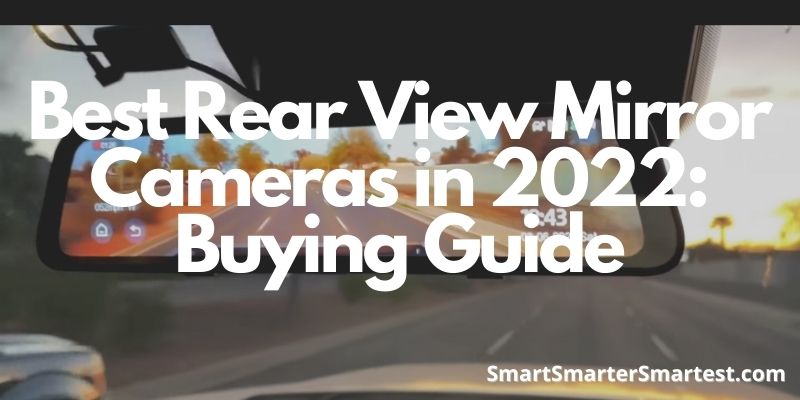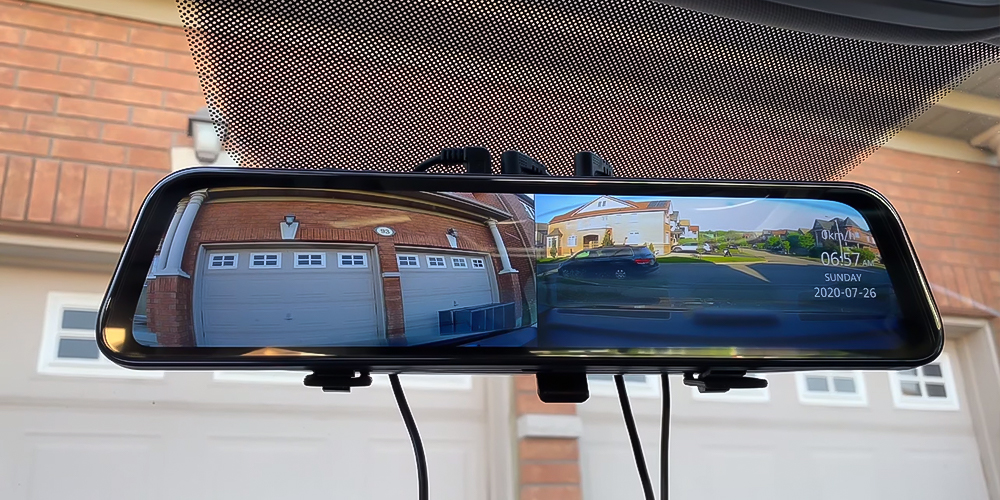Dashboard cameras, or “dash cams,” are becoming more and more popular, which means that there’s an ever-growing range of products on the market. The rearview mirror-mounted version probably remains the favorite, for several reasons.

Thanks to a convenient placement that doesn’t impair visibility, this kind of dash cam doesn’t cause any legal issues – it simply fills in the space normally occupied by your vehicle’s standard rearview mirror. They are also typically easy to install and difficult for potential thieves to identify, since they blend in with your car’s factory appearance.
A Buyer’s Guide for Rearview Mirror Dash Cams
First, let’s begin by identifying the dash cam’s basic attributes. Then we can determine which one is the best buy.
Dashboard cameras are usually installed inside your car, directed through the windshield. Most dash cams film regardless of whether the car is in motion or parked, and can be controlled through an application that is accessible via personal computer or smartphone.
When it comes to purchasing a dash cam, you’ll likely want to find one that is easy to install, simple to operate, and records what you want it to. Beyond that, there are many more advanced features that you might want to think about.
But with all the options and features that dashboard cameras offer, finding the one that’s right for you can seem overwhelming. To help you narrow things down, there are five key factors to think about that will narrow the range of your search.
Quality of the Image
Image quality is perhaps the most important factor to consider when perusing available dash cams, and it does vary significantly depending on the model. You’ll likely want one with a resolution of 1080 pixels to ensure that you will be able to make out faces and license plates on the recordings.
Another important attribute you’ll probably want to look for is a glass lens, which will function well under both high and low lighting conditions. Be advised, when it comes to cameras, quality and cost tend to be closely related, so a high resolution image at all hours of the day and night likely won’t come cheap.
Sturdiness
As your camera is going to be in motion with the rest of the car (and fender benders do happen), a fragile dashboard camera is the last thing you want.
That’s especially true if you’re considering an externally mounted camera, which may be affected by inclement weather as well as traffic conditions and road wear and tear. Fortunately, many dash cams are waterproof and/or shock resistant. Think about where the camera is going to be mounted and what type of driving conditions it will be subject to before you make a decision about what features are worth paying for or not.
Ease of Operation
Certain rearview mirror dashboard cameras can do all sorts of tricks. Do you want one that can rotate to change its field of vision? How about one that that zoom in and out? Or automatically take snap shots after a certain interval of time has passed?
Maybe you just want something that will reliably record what happens in front of the vehicle without any hassles. You can buy a dash cam that is user friendly, or that has all sorts of complex functionalities. These two options are usually on opposite ends of the spectrum. It’s up to you to decide where yours will fall.
Bonus Features
Besides filming and recording, what else can dashboard cameras do? You might be surprised. Some have Wi-Fi connectivity that allows them to communicate with your cell phone, voice control technology so you can tell them when to start or stop recording, and GPS antennae that allow them to take over navigation duties for your phone.
They can also precisely document your vehicle’s speed over any trajectory or period of time. That might come in handy if you find yourself saddled with an unjust traffic violation… or need to provide an alibi?
Price
Finally, you should probably set some limits on how much you want to spend. Rearview mirror dash cams can cost less than 50 bucks or as much as several hundred dollars.
If you’re just looking for a simple, every day workhorse that records in one direction, there are many reasonably priced options out there. If you want all the latest bells and whistles and are ready to pay for them, there are some really impressive (and expensive) gadgets on the market, too. Do yourself a favor and jot down your price range early on in the buying process, then stick to it.
FAQS
How Do I Emplace My Rearview Mirror Dashboard Camera?
All of the products listed here arrive with easy-to-understand instructions to walk you through the dash cam installation process. In most cases, you could probably get along without them. All you’ll really need is a power source to plug into, usually your vehicle’s auxiliary power outlet (a.k.a. the cigarette lighter socket). But be careful to avoid obstructing your field of vision with the power cable.
Just How Much Does a Rearview Mirror Dashboard Camera Usually Cost?
As was mentioned earlier, dash cams can vary widely in terms of price, depending on the complexity and functionality of the model. If you’re looking for a good product at a reasonable price, there are plenty of excellent options listed on this page in the $60 to $120 price range.
Does My Dash Cam Record Even When the Ignition is Turned Off?
Some do, and some do not. For your dashboard camera to be able to film while the vehicle is not running, it will need to be connected to the car’s battery. This is a special feature that usually involves a more complex installation and is not available on many of the more affordable dash cam models.
Now that you have a better idea of what rearview mirror-mounted dashboard camera options you have to choose from, it’s time to pick out the model with the capabilities and price tag that are right for you. The sooner you do, the less time your car will be without this high tech layer of protection.



